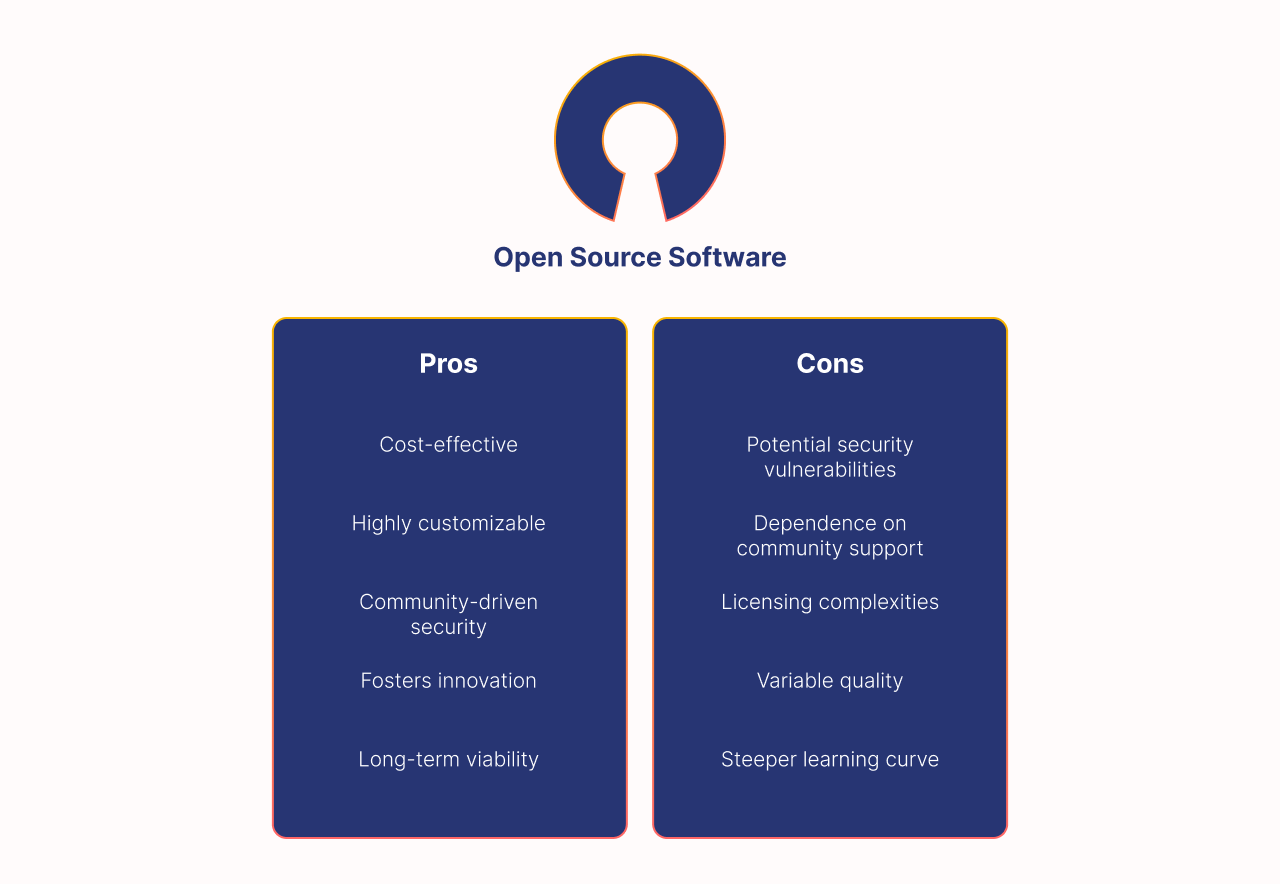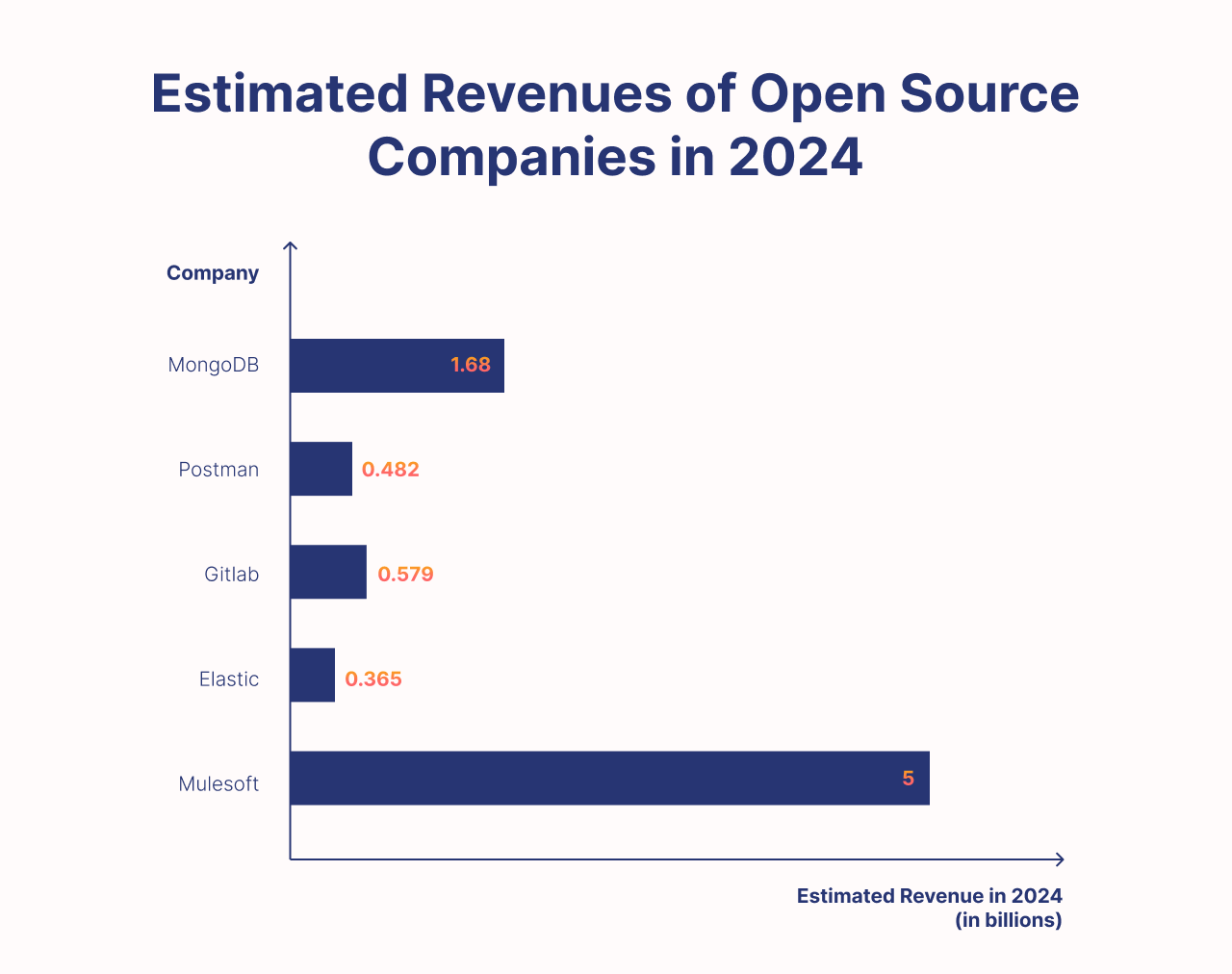Open source software is not just a collection of free code; it’s a movement that has revolutionized how we create, share, and use technology. From operating systems like Linux to widely used programming languages like Python, open source fuels collaboration. Transparency, the freedom to tinker, and a sense of community set open source apart. Let’s explore what makes open source software so impactful, where it came from, and how it continues to shape our lives today.
What is open source software?
Open source software has a transparent code base that can be altered or redistributed with far fewer legal restrictions compared to proprietary software. Simply put: you can frequently use open source software without paying a dime. It might be a computer app like Mozilla Firefox, an entire operating system such as Linux, or even a programming language like Python. The possibilities are nearly endless; if software exists, a similar open source alternative likely does, too.
On the other hand, proprietary software comes with strict boundaries. Companies writing proprietary code limit who can access it, what, if any, parts can be changed, and how it can be redistributed. For example, a security software company would be unlikely to grant access to its proprietary code to ensure it remains effective and secure.
While proprietary software thrives on centralized control, open source software depends on a collaborative, community-driven model for distribution and improvement.
Differences between proprietary and open source software
|
Proprietary software |
Open source software |
|---|---|
|
Code must be purchased from the company who maintains it. |
Code is open to anyone who wants to develop or use it. |
|
Legal permission and negotiations must take place for any modification or redistribution. |
Code can be modified and redistributed by anyone. |
|
Limits on changing the software features. |
Unlimited software changes. |
History of open source software
How did open source begin? In the 1970s and early days of computing, software distribution practices varied widely. Some companies included source code with purchases, while others kept it proprietary. Strict Non-Disclosure Agreements (NDAs) stopped businesses from sharing or altering the code, leaving them with little flexibility to adapt software to their needs The shift toward closed source became more prominent as the commercial software industry grew.
Still, there were communities that believed in promoting software freedom and openly sharing a Unix operating system (OS) codebase. One such community resided at the University of California, Berkeley in 1974. Programming students and computing professors started to alter Unix code and shared their work amongst one another. As the code was altered, it was released under a new license called the Berkeley Software Distribution (BSD) license.
Richard Stallman decided to bring this kind of open code OS to the commercial software industry in 1983. He announced plans for GNU (GNU’s Not Unix), a free OS that developers could modify and share. At the first Hackers Conference in California, USA, Stallman argued that software should be “accessible to everyone as freely as possible.” In 1985, Stallman had published the GNU Manifesto and invited developers to contribute to this new movement.
Evolution over time
By 1989, developers worldwide had adopted the GNU operating system. The FSF released the GNU General Public License (GPL), which guaranteed that software licensed under it would always remain free and open for modification. In 1999, the FSF went further by launching a public directory of free software. This initiative brought open source to the forefront of the software industry, where it continues to thrive today.
How open source software works
Now we know about the history of open source and what it is, let’s talk about how it works. The code is stored in a public repository that anyone can access, generally in a version control system like GitHub or BitBucket. Anyone can copy the code and work on it themselves. This is especially important in an open source environment, where it’s up to the community to improve on and maintain the software. Transparency is number one when it comes to open source.
Even commercial grade open source apps and programming languages rely on the community to report bugs, solve user needs, and collaborate with other developers online. Contributor guides, codes of conduct, and even pull request automations enforce code standards that developers need to follow.
Just because software is open source does not mean it’s free. Some apps have paid groups of developers who maintain the core code, like the notes app Obsidian or the programming app Sublime Text. These types of apps rely on donations, or sell premium features to help maintain a base cost of their software and team. The type of open source license determines how you are allowed to use the software.
Popular open source licenses
Distribution licenses protect the code base. Two major license types are:
- Permissive: These are flexible, allowing developers to add their own copyright and commercialize their version. Licenses like MIT and Apache 2.0 are especially popular among businesses.
- Copyleft: These ensure that any software derived from the original remains free and open. For example, the GNU GPL guarantees that future versions of a project cannot become proprietary.
There are different metrics and measurements on codebases and their licensing. As of December 2024, 42% of open source repositories on GitHub use a GNU GPL license. And in a 2024 report on open source security, Black Duck reported that 92% of the evaluated codebases used the MIT license. These are both significant numbers: both copyleft and permissive licensing are popular.
Why licensing matters
Licensing protects the software thanks to the legal boundaries set on how it can be used. Whether that means that the license allows free distribution, or it means that the license protects the intellectual property of an organization or person depends on the type of license. But ultimately, every software made for redistribution should be licensed in some capacity. There must be a clear path forward for the use of the software by the public.
Open Source Software examples and applications in the real world

It’s clear that open source software is used in various industries, including operating systems, web browsers, programming languages, and more. 60% of codebases contain open source software. Linux, the open source OS, fuels over 90% of web servers and internet-connected devices. Apache HTTP web server runs ~28% of the internet. This is just the beginning of the statistics showing how much of the world runs on open source. Numerous popular open source apps are used by millions of people daily, like Mozilla Firefox, VLC Media Player, and GIMP.
Open source powers the world, and that includes the world of development. Technology would not have advanced the way it has in the 2000s without the open source community’s contributions. Whole programming languages are open source, like Python, JavaScript, Perl, Java, PHP, and more. Development tools like Visual Studio Code, Kubernetes, TinyMCE, and Jenkins are used by over 14 million people.
There are also many projects using open source code that work to make a real difference in the world. The altruistic nature of many open source projects embodies the overarching open source values of transparency, collaboration, and advancement of technology.
Tidepool
830 million people worldwide have diabetes, and live with the challenges of keeping track of their readings. Medical professionals need to integrate data from different devices for different patients into one place for analysis. Tidepool is an OSS that allows diabetes patients and their doctors to easily share health information that eliminates this problem. It aggregates important data from various devices, such as:
- Blood sugar meters
- Continuous glucose monitors
- Insulin pumps
- Apple Health readings
The data is shared with the patient’s medical care team, and Tidepool users also have the option to share critical information about their health with others. If their caregivers, family, or friends need that info, they can quickly share it when necessary. Tidepool makes monitoring diabetes easier for medical professionals and for the patients managing the condition.
SignDict
SignDict is a small German open source software company that has created an interactive sign language dictionary for signers and new students of the language. The founders realized the importance of a comprehensive sign-language dictionary for German sign language. Anyone around the world can contribute to the repository by adding code, or adding a missing sign with their camera and a short video. The project aims to provide as many signs as possible in as many languages as possible.
LF Energy
Linux Foundation Energy, or LFEnergy, is an open source company dedicated to creating a technology ecosystem that benefits the environment, rather than harms it. According to MIT, a single data center uses the same amount of energy as 50,000 homes annually. That’s a greater annual carbon footprint than air travel. LFEnergy creates open source tools surrounding renewable energy sources, making the electric grid easier to operate and scale. This way, more enterprises will make cleaner, better energy choices for the planet.
Let’s Encrypt
Last but not least in our open source software examples is Let’s Encrypt, a non-profit that provides encrypted TLS and SSL certificates to over 500 million websites. Their goal is to create a more secure web with better privacy restrictions, by making secure HTTPS certificates available for free. Any website can get a TLS/SSL certificate for their domain and ensure the site’s security and privacy for users and visitors. Free, automatic, and transparent are the biggest principles at Let’s Encrypt, showing that they embody the open source values.
Benefits of open source software
Open source isn’t just about free tools—it’s about fostering innovation, collaboration, and efficiency on a global scale. Here’s why open source is so widely embraced:
Encourages alterations
Proprietary software often restricts modifications, forcing businesses to work within its limitations. Open source flips the script by giving developers partial to full access to the codebase. This freedom enables organizations to customize software for their unique needs, unlocking new potential.
Builds community
Open source thrives on collaboration. Developers from around the world contribute improvements, report bugs, and share insights. This collective effort often results in faster problem-solving and a stronger, more resilient product. In some cases, issues are already resolved by the community before a user even encounters them.
Dual security model
Contrary to popular belief, open source software can be highly secure. Publicly accessible code invites scrutiny from countless developers, who identify and patch vulnerabilities quickly. Many major open source projects combine community oversight with professional security management, undergo security audits, and maintain certified compliance. This dual security model is only as effective as its participants, but with engaged communities and major open source projects backed with professional security certification, open source often outpaces proprietary software in responsiveness.
Lowers costs
Public code means no licensing fees, significantly reducing initial investment costs. While implementing open source may require skilled developers and integration time, the long-term savings often outweigh these upfront expenses. For small businesses, open source can be a game-changer.
Sparks innovation
Former Facebook engineer Martin Traverso captured the essence of open source: “Open source has cultivated a community of innovation that wouldn’t otherwise exist.” By sharing ideas and solutions freely, developers create a fertile ground for breakthroughs, fueling progress that benefits the entire tech ecosystem.

Challenges of Open Source Software
Open source software is an incredible boon to the world of software development. But, as with any tool, it’s not perfect. What challenges arise when using open source software?
Security requires responsibility
Secure open source software (OSS) exists, but keeping it secure requires effort. Public repositories allow anyone to inspect the code, which makes it easier to spot vulnerabilities but also easier for bad actors to exploit them.
Maintaining strong security practices is critical. Developers need to know who contributes to the code, track dependencies, and stay vigilant about security updates. Open source security is a shared responsibility, and the transparency that fosters collaboration can also create risks when responsibility isn’t prioritized.
No guaranteed support
Proprietary software offers formal support through dedicated teams or service contracts. Open source lacks this structure. Instead, support depends on the size and engagement of the community.
For small businesses and enterprises alike, this can pose challenges. If an open source point-of-sale system crashes at a bakery or if an enterprise server fails, there’s no hotline to call. Organizations relying on OSS must either invest in in-house expertise or take on the risk of delayed resolutions.
Dependency and compatibility issues
Open source projects often depend on other OSS components, creating a web of interdependencies. When one component updates, it can cause breaking changes in others, leading to unexpected failures.
For instance Baby Buddy, a health-tracking app, relies on Python, an open source programming language. If Python introduces a breaking change, Baby Buddy’s developers may need to update their app urgently. This kind of cascading issue adds hidden maintenance costs that organizations must be prepared to handle.
The role of Open Source Software in business and enterprise

Over the past 30 years, hundreds of companies have built successful businesses around open source. This model isn’t just for large-scale providers like Red Hat; many smaller companies have found ways to thrive by creating useful open source solutions and monetizing their expertise.
MongoDB was created for scalable databases
The MongoDB team designed a scalable database solution that addressed the limitations of traditional databases. By offering a Community Edition for free and a paid Enterprise Server with features like low latency and advanced security, they created a dual model that supports both developers and enterprises. In 2024, MongoDB’s estimated revenue reached $1.68 billion.
Postman builds APIs with transparency
Postman provides open source SDKs, runtimes, and tools that simplify API creation. Their transparency about open source contributions aligns with the ethos of the OSS community. To serve larger organizations, Postman offers subscription-based business and enterprise plans. Their 2024 revenue is projected at $482 million.
GitLab delivers DevOps solutions with an open foundation
GitLab’s Community Edition supports open source projects with features like static site editing, design management, and CI/CD pipelines. Enterprises looking for additional security and support can opt for paid plans, which include private repositories and other advanced tools. GitLab’s estimated revenue for 2024 is $579 million.
Elastic creates powerful search tools
Elastic is built on the open source Apache Lucene library and provides powerful search software. The project’s open foundation allows contributors to rapidly identify and patch security vulnerabilities. Elastic’s freemium model supports a range of users, from individual developers to large enterprises, contributing to its $365 million revenue in 2024.
Mulesoft integrates enterprise software
Mulesoft’s API platform simplifies the integration of enterprise software, enabling smoother workflows. While its core offerings are open source, Mulesoft generates most of its revenue, through enterprise subscriptions and premium services. That made Mulesoft an estimated $5b in 2024.
The future of Open Source Software
The future of open source looks bright but demands sustained care and attention. Rebecca Ackermann at MIT likened OSS to a “free puppy”: it might not cost money upfront, but it requires maintenance to thrive.
Organizations like NASA, Google, Spotify, and the Ford Foundation continue to fund open source projects, reflecting a growing recognition of its value. Meanwhile, GitHub crossed 100 million developers in 2024, showing the increasing global engagement with open repositories.
However, sustaining open source means addressing challenges like outdated projects and unmaintained code. Many OSS founders move on, leaving their repositories in limbo. Without proper care, these projects accumulate technical debt, limiting their usefulness.
Moving forward, open source must balance collaboration with sustainable funding and maintenance. Its transparency and community-driven ethos will continue to shape the future of software development, as long as these challenges are met with proactive solutions.
Wrap up
We’ve explored what open source software is, how it works, where it came from, and how it has shaped the world. Forty years after the launch of GNU, open source has grown into a cornerstone of modern technology.
Whether you’re browsing the web, running a server, or developing the next big app, open source plays a role in your digital experience. It fosters innovation, builds community, and powers global collaboration like no other model.
To learn more about OSS, check out our other articles:
